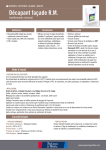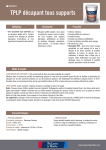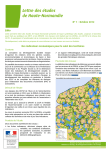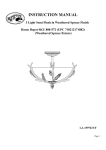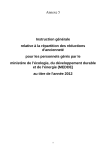Download Energizer e2 User's Manual
Transcript
Page 1 of 3 Lithium L91 Batteries 10/17/01 The information contained within is provided for your information only. This battery is an article pursuant to 29 CFR 1910.1200 and, as such, is not subject to the OSHA Hazard Communication Standard requirement for preparation of a material safety data sheet. The information and recommendations set forth herein are made in good faith and are believed to be accurate as of the date of preparation. However, EVEREADY BATTERY COMPANY, INC., MAKES NO WARRANTY, EITHER EXPRESS OR IMPLIED, WITH RESPECT TO THIS INFORMATION AND DISCLAIMS ALL LIABILITY FROM RELIANCE ON IT. PRODUCT SAFETY DATA SHEET PRODUCT NAME: EVEREADY Battery Type No.: L91 Volts: 1.5 TRADE NAME: ENERGIZER, Lithium-Iron Disulfide Battery Approximate Weight: 14.5 grams CHEMICAL SYSTEM: Lithium-Iron Disulfide Designed for Recharge: No SECTION I - MANUFACTURER INFORMATION Eveready Battery Company, Inc. 25225 Detroit Road Westlake, OH 44145 Telephone Numbers for Information: (440) 835-7368 (800) 383-7323 (USA) Date Prepared: October 17, 2001 SECTION II - HAZARDOUS INGREDIENTS IMPORTANT NOTE: The battery should not be opened or burned. Exposure to the ingredients contained within or their combustion products could be harmful. MATERIAL OR INGREDIENT PEL (OSHA) TLV (ACGIH) %/wt. Carbon Black 3.5 mg/m3 TWA 3.5 mg/m3 TWA 0-4 (CAS# 1333-86-4) 1,2-Dimethoxyethane None established None established 5-8 (CAS# 110-71-4) 1,3-Dioxolane None established None established 2-5 (CAS# 646-06-0) Graphite 15 mg/m3 TWA (total dust) 2 mg/m3 TWA (respirable 0-4 (CAS# 7782-42-5) 5 mg/m3 TWA (respirable fraction) fraction) Iron Disulfide None established None established 24-27 (CAS# 1309-36-0) Lithium or Lithium Alloy None established None established 6-7 (CAS# 7439-93-2) Lithium Iodide None established None established 0-3 (CAS# 10377-51-2) SECTION III - FIRE AND EXPLOSION HAZARD DATA In case of fire where lithium batteries are present, apply a smothering agent such as METL-X, sand, dry ground dolomite, or soda ash, or flood the area with water. A smothering agent will extinguish burning lithium batteries. Water may not extinguish burning batteries but will cool the adjacent batteries and control the spread of fire. Burning batteries will burn themselves out. Virtually all fires involving lithium batteries can be controlled with water. When water is used, however, hydrogen gas may evolve. In a confined space, hydrogen gas can form an explosive mixture. In this situation, smothering agents are recommended. Fire fighters should wear self-contained breathing apparatus. Burning lithium-iron disulfide batteries produce hydrogen sulfide gas, sulfur dioxide gas, toxic and corrosive lithium hydroxide fumes. 2001 EVEREADY BATTERY COMPANY, INC. Page 2 of 3 Lithium L91 Batteries 10/17/01 SECTION IV - HEALTH HAZARD DATA Under normal conditions of use, the battery is hermetically sealed. Ingestion: Swallowing a battery can be harmful. Contents of an open battery can cause serious chemical burns of mouth, esophagus, and gastrointestinal tract. If battery or open battery is ingested, do not induce vomiting or give food or drink. Seek medical attention immediately. CALL NATIONAL BATTERY INGESTION HOTLINE for advice and follow-up (202-625-3333) collect, day or night. Inhalation: Contents of an open battery can cause respiratory irritation. Provide fresh air and seek medical attention. Skin Absorption: Dimethoxyethane and dioxolane may be absorbed through the skin, causing localized inflammation. Skin Contact: Contents of an open battery can cause skin irritation and/or chemical burns. Remove contaminated clothing and wash skin with soap and water. If a chemical burn occurs or if irritation persists, seek medical attention. Eye Contact: Contents of an open battery can cause severe irritation and chemical burns. Immediately flush eyes thoroughly with water for at least 15 minutes, lifting upper and lower lids, until no evidence of the chemical remains. Seek medical attention. Note: Carbon black is listed as a possible carcinogen by International Agency for Research on Cancer (IARC). SECTION V - PRECAUTIONS FOR SAFE HANDLING AND USE Storage: Store in a cool, well ventilated area. Elevated temperatures can result in shortened battery life. Mechanical Containment: Containment of this battery in a manner that obstructs or defeats the safety vent or electrical disconnect mechanisms designed into this battery can result in fire and/or explosion and cause personal injury and device damage. This battery is not designed to be potted, enclosed in hermetic overpackaging, or sealed by any means that prevents free operation of the designed safety mechanisms. Handling: Accidental short circuit for a few seconds will not seriously affect the battery. Prolonged short circuit will cause the battery to lose energy, and can cause the safety release vent to open. Sources of short circuits include jumbled batteries in bulk containers, metal jewelry, metal covered tables or metal belts used for assembly of batteries into devices. If soldering or welding to the battery is required, consult your Eveready Battery Company representative for proper precautions to prevent seal damage or short circuit. Charging: This battery is manufactured in a charged state. It is not designed for recharging. Recharging can cause battery leakage or, in some cases, high pressure rupture. Inadvertent charging can occur if a battery is installed backwards. Labeling: If the Eveready label or package warnings are not visible, it is important to provide a package and/or device label stating: WARNING: FIRE, EXPLOSION, and BURN HAZARD. DO NOT OPEN BATTERY, DISPOSE OF IN FIRE, HEAT ABOVE 100° C (212° F), EXPOSE CONTENTS TO WATER, RECHARGE, PUT IN BACKWARDS, MIX WITH USED OR OTHER BATTERY TYPES - MAY EXPLODE OR LEAK AND CAUSE PERSONAL INJURY. Where accidental ingestion of small batteries is possible, the label should include: WARNING: (1) KEEP AWAY FROM SMALL CHILDREN. IF SWALLOWED, PROMPTLY SEE DOCTOR; HAVE DOCTOR PHONE (202) 625-3333 COLLECT. (2) FIRE, EXPLOSION, BURN HAZARD. DO NOT OPEN BATTERY, DISPOSE OF IN FIRE, HEAT ABOVE 100° C (212° F), EXPOSE CONTENTS TO WATER, RECHARGE, PUT IN BACKWARDS, MIX WITH USED OR OTHER BATTERY TYPES - MAY EXPLODE OR LEAK AND CAUSE PERSONAL INJURY. Disposal: Dispose in accordance with all applicable federal, state and local regulations. 2001 EVEREADY BATTERY COMPANY, INC. Page 3 of 3 Lithium L91 Batteries 10/17/01 SECTION VI - SPECIAL PROTECTION INFORMATION Ventilation Requirements: Not necessary under normal conditions. Respiratory Protection: Not necessary under normal conditions. Eye Protection: Not necessary under normal conditions. Wear safety glasses with side shields if handling an open or leaking battery. Gloves: Not necessary under normal conditions. Use neoprene or natural rubber gloves if handling an open or leaking battery. SECTION VII - REGULATORY INFORMATION The transportation of lithium batteries in the types and sizes manufactured or sold by Eveready Battery Company is not regulated by the U.S. Department of Transportation or the major international regulatory bodies. However, to maintain this unregulated status, the batteries must be packaged in a manner as to prevent short circuits and be packed in strong outside packaging. SARA/TITLE III - As an article, this battery and its contents are not subject to the requirements of the Emergency Planning and Community Right-To-Know Act. 2001 EVEREADY BATTERY COMPANY, INC.



